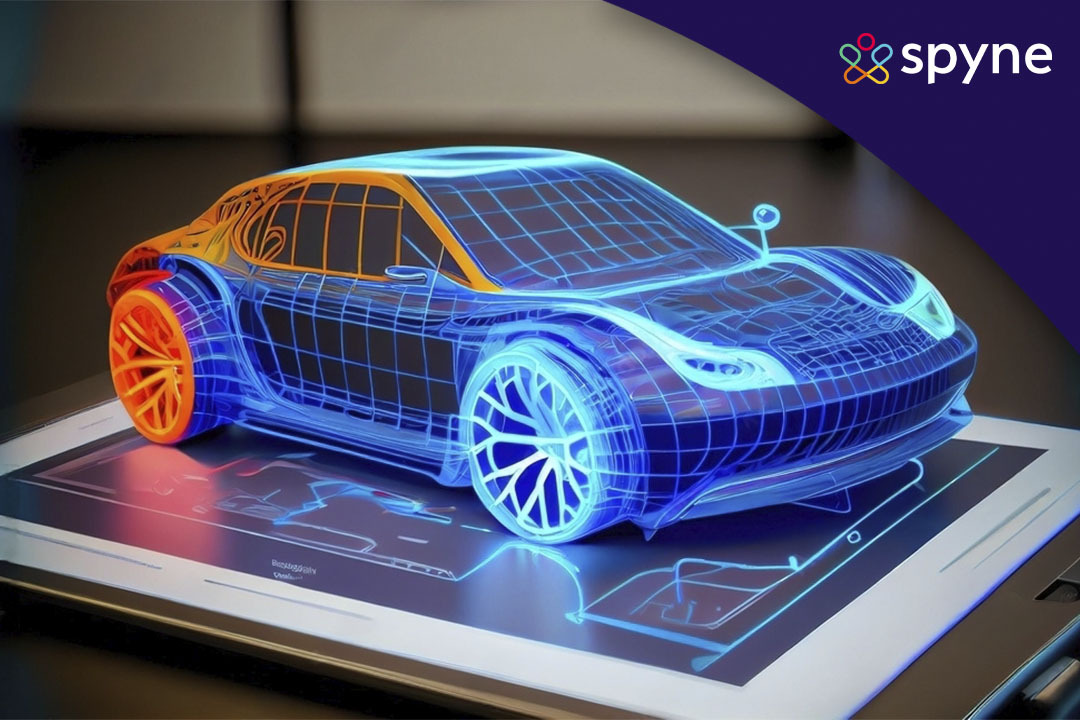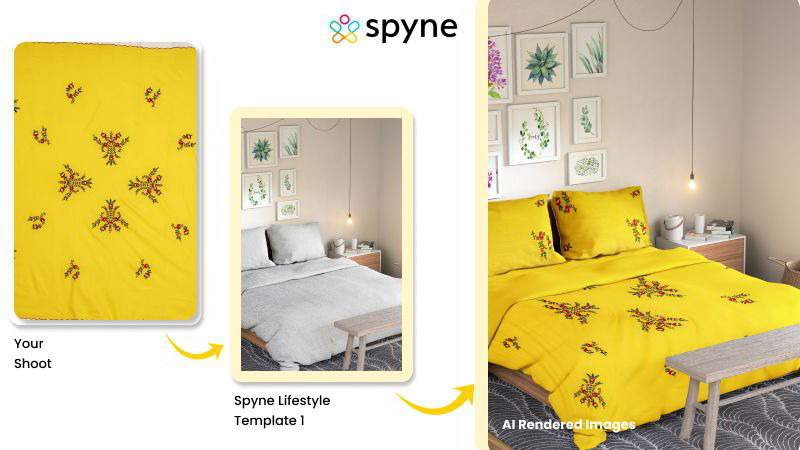Curious about the fascinating world of 3D rendering and how it can bring your creative vision to life? Welcome to our 3D rendering blog! Spyne is happy to help with their knowledge and expertise with you and guide you through the advantages of this technology.
Whether you’re an architect looking to create realistic drawings for new architectural projects, a product designer to showcase your new creations, or a car dealer looking to advertise your used cars, 3D rendering can help you achieve your goals from the basics of 3D modeling to the latest rendering techniques and hardware. We cover all aspects of the business and provide expert advice and guidance to help you succeed.
Join us as we explore the incredible possibilities of 3D rendering and how it can change how we create and experience digital content.
What is 3D Rendering?
3D rendering means creating 2D images or video animations using computer-generated 3D models. It can be photorealistic or stylized, as per the user’s requirements. This process involves using advanced software to design 3D models, add textures to different surfaces, and calculate how light and shadow will interact with the surfaces. It has many applications, including product design, architecture, video game development, animation, and film.
It is often used with 3D modeling software to create realistic 3D rendering images of objects. As the objects are designed virtually, you don’t need to create them physically, allowing designers, architects, and artists to visualize and communicate their ideas before they come to life.
Processing can be done in real-time or through a batch process where the computer performs the calculations overnight or for hours or days. Many factors can affect processing time, such as model complexity, level of detail, and desired output quality.
Types of 3D Rendering
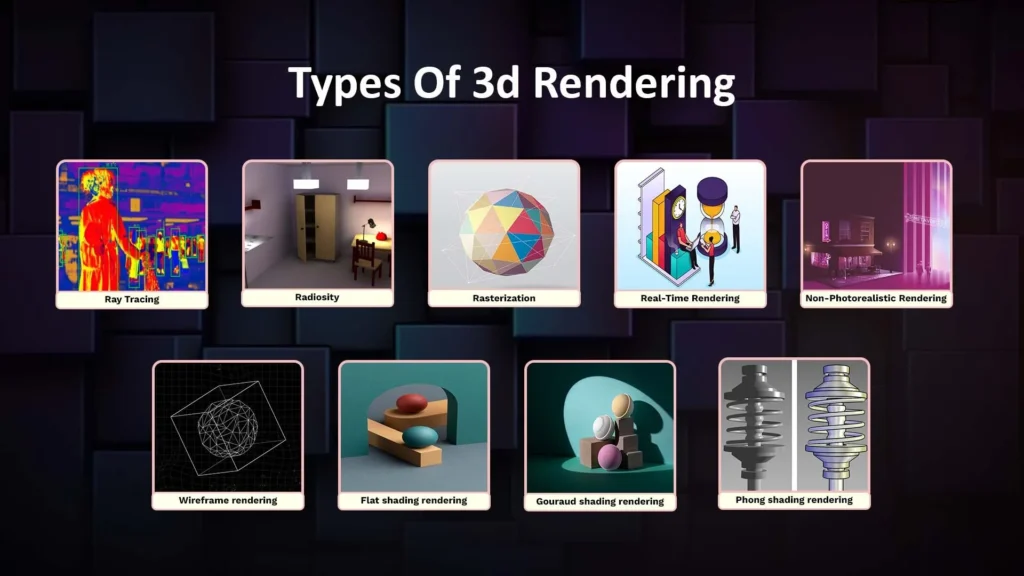
There are many different three-dimensional rendering techniques, each with its own advantages and limitations. Some of the different types of 3D rendering are
Ray Tracing, is a technique that simulates how light behaves when interacting with objects in a 3D scene. It creates realistic and lifelike 3d rendering images with soft shadows, reflections, and effects but is computationally intensive and time-consuming.
Radiosity: Radiosity is a global illumination process that simulates how light reflects off objects in a scene. It can create realistic images with soft shadows and realistic lighting, but it can take effort and time.
Rasterization: It is a rendering technique that transforms 3D geometry into 2D images. Using techniques similar to text in real-time applications. It is fast and efficient but produces lower-quality images than other processing methods.
Real-Time Rendering: We use real-time rendering techniques in video games and interactive applications. That renders images at an interactive rate (usually at least 30 frames per second).
Non-Photorealistic Rendering: Non-photorealistic rendering (NPR) creates realistic images or cartoons instead of reality. It can be used for art presentations or to create a beautiful look for a project.
Wireframe rendering: This type of rendering displays only the lines and edges of the object without any shading or texture.
Flat shading rendering: This technique applies a single color to each polygon in the model without any shading or texture.
Gouraud shading rendering: This technique uses an interpolation algorithm to calculate colors at the vertices of the polygons and then shades the rest based on those colors.
Phong shading rendering: This technique uses a more complex algorithm than Gouraud shading to calculate the surface normals at each pixel and then apply shading and texturing based on the normals.
Which Industries use 3D Rendering Services?
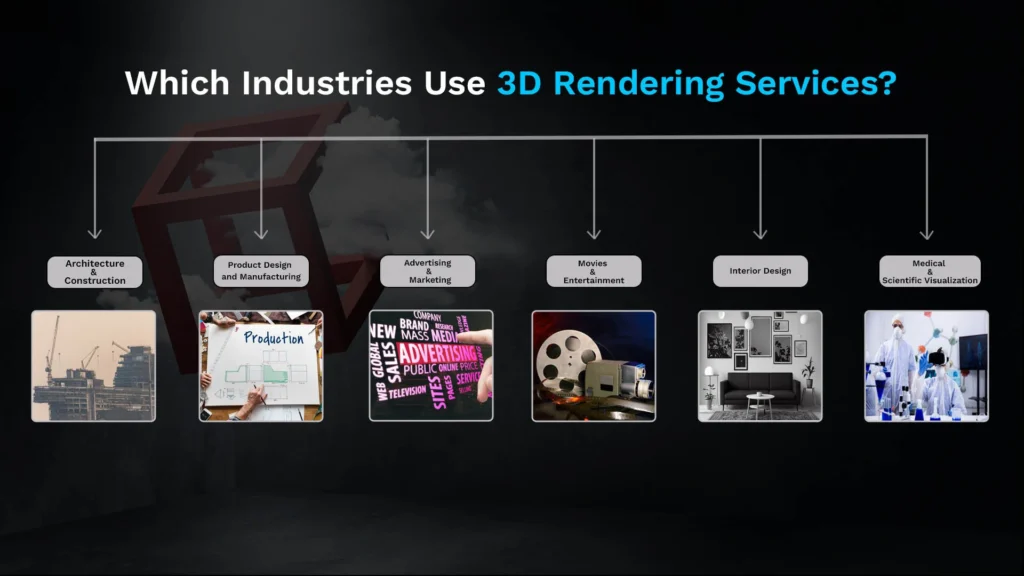
3D rendering services are used by many industries, including:
Architecture & Construction: Businesses use this to create realistic models of buildings, interiors, and landscapes. Architects and builders use these models to visualize and communicate design concepts to customers and stakeholders.
Product Design and Manufacturing: Use Rendering services to create realistic and accurate product prototypes before production. This helps reduce costs and reduce errors during design and manufacturing.
Advertising and Marketing: Professionals use 3D rendering services to create high-quality images and graphics for promoting products and services in print and digital media.
Movies & Entertainment: These services are used to create special effects and CGI for movies, TV shows, and video games. This includes character design, animation, and virtual environments.
Interior Design: 3D rendering services to create realistic models of interiors, including furniture, lighting, and decoration. This helps designers and clients visualize and decide on their design ideas.
Medical and Scientific Visualization: 3D rendering services are used to create models and animations of medical and scientific data. This can include anatomical models, molecular structures, and simulations of scientific processes.
Why Does Your Business Need it?
If you plan to get 3D Rendered visuals for your business, here are a few aspects to help your business become more streamlined.
Saves Time: Regarding interior designing, 3D Rendering can save you time. All you need to do is choose the Best 3D Rendering Company. It also helps you save a lot of effort in preparing a scene for representation.
Reduces Cost While Increasing Operational Efficiency: Businesses are saving considerable money by using this. And this is due to the fact that they no longer have to spend money on creating actual models or prototypes.
More Profitable: Since the process costs less money and time, it is automatically more profitable for businesses. And not only that, it leaves a very promising impression on your audience.
Takes Your Branding And Marketing To A Whole New Level: We often say here at Spyne that visual content used for branding and marketing purposes defines a business. Obtaining 3D Rendered Visuals can help your business easily sell its services.
Makes You Stand Out Among Competitors: With today’s stiff-neck market competition, as a business, you need to do everything you can to make a unique brand identity for yourself. And opting for 3D Rendering services is surely a great choice.
A Lot More Convenient: Showing your clients and investors the hard copy of the design every time is not ideal and requires much effort. So, to make this experience a lot more convenient, more and more brands are moving towards 3D Rendering to showcase their offerings in 3D rather than just 2D.
Use Cases of 3D Rendering
Three-dimensional rendering uses computer software to create 2D images or animations from 3D models. 3D rendering has many applications in various industries. For example,
1. Automotive Industry
In the Automotive industry, businesses create virtual prototypes of cars, design car interiors, and design products. It helps designers to see and test different design ideas, improve the ergonomics of the car interior, and now cars more beautifully.
2. Product Visualization
It can create visualizations that showcase products from different angles and contexts. This helps customers to see what a product looks like from all angles and understand how it might fit into their lives.
3. Customization
People use this to create customizable products that customers can personalize and design according to their preferences. This includes furniture, jewelry, and clothing, where customers can choose different colors, materials, and sizes. This is used in Ecommerce photography.
4. Virtual Try-On
Create virtual try-on experiences for clothing, eyewear, and makeup products. This allows customers to see what a product will look like on them before making a purchase and to experiment with different styles and colors.
5. Design Industry
People use this in the design industry to create models of machines, tools, and other objects. It helps designers test and improve their designs, reduce production costs, and streamline production processes.
6. Architecture and interior design
Architects and interior designers widely use it to create realistic visualizations of buildings, interiors, and landscapes in architecture and interior design. It helps them present their designs to clients before they are built.
7. Product Design and Manufacturing
Product designers use 3D rendering to create virtual prototypes of products before manufacturing. It helps designers test and improve their designs, reduce production costs, and streamline production processes.
8. Medical and Visualization
People use this in medical and scientific visualization to visualize complex materials and structures such as bodies, cells, and molecules. It helps researchers visualize and analyze data more comprehensively.
9. Education
Education uses 3D imaging to visualize complex concepts and structures such as the human body, geological formations, and historical buildings. It helps students understand the content more broadly and interact with the information more deeply.
In general, 3D machining has many applications in industry, and as technology advances, its importance continues to increase, and the need for efficient and effective machining increases.
3D Rendering Vs. 3D Modeling
3D rendering and 3D modeling are crucial in creating 3D graphics, but they are different. Let’s take a brief look at the difference between the two:
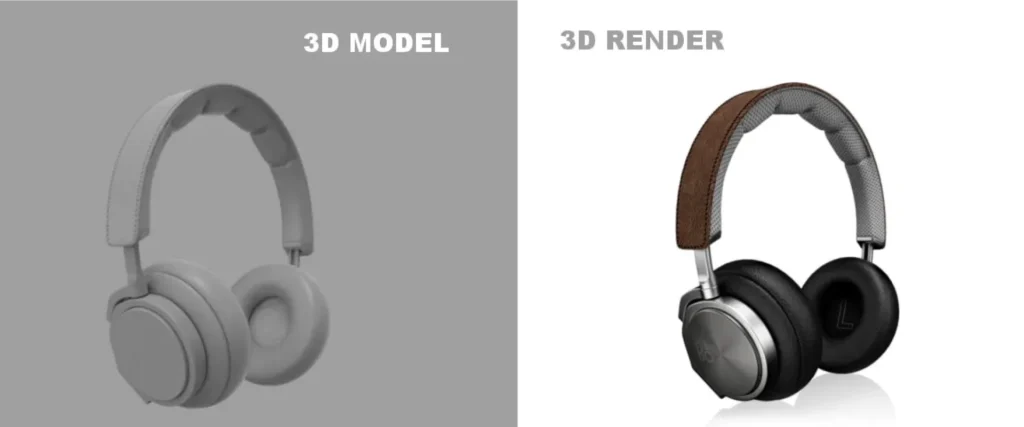
3D modeling means creating a digital representation of an object or scene in 3D, a.k.a, in three dimensions. This process involves the creation of a virtual 3D model by defining its geometry, texture, lighting, and other properties. People use the resulting model for various purposes, including visualization, animation, and simulation.
On the other hand, 3D rendering involves visualizing said 3D models in different environments, showcasing them as images or animated videos. This process involves calculating the scene’s light interactions and other effects to create a realistic image. We use the resulting image or animation for various purposes, including product photography, marketing materials, and entertainment.
In short, 3D modeling is creating a digital 3D model, while 3D rendering is generating a 2D image or animation from that model. Both processes are important in creating 3D graphics and are often used together to create high-quality visuals.
3D Rendering Techniques
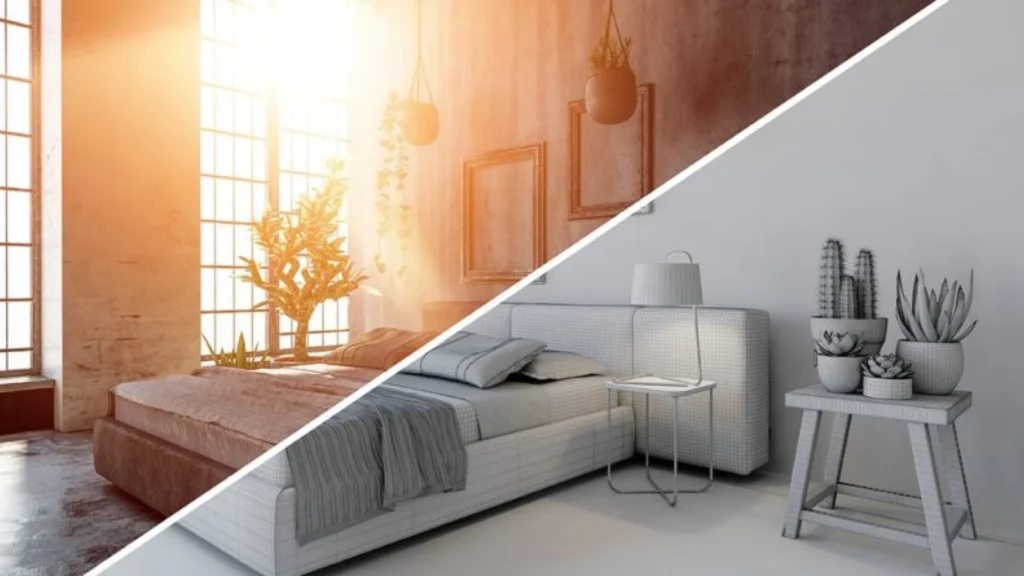
There are several rendering techniques commonly used in 3D computer graphics:
- Global illumination: This technique combines ray tracing and radiosity to more accurately simulate how light behaves in a scene. It considers direct and indirect lighting and can produce realistic images with accurate shadows and reflections.
- Ambient occlusion: This technique simulates whether objects are blocking light in space. Calculates the amount of ambient light that can reach any point in space, including light from other objects. This can create realistic shadows and shadows, especially in areas where objects are close together.
- Depth of Field: This technique simulates how a camera lens focuses on objects at different distances. People also use this to create a better sense of depth in a scene by blinding objects.
- Motion Blur: This process simulates the blur that occurs when objects move rapidly through space. We also use this to create a sense of motion in animations.
- Cel Shading: This technique creates graphics like 3D animation. Instead of trying to simulate lighting and shadows, it uses solid colors and black layers to create a 2D effect.
These are the five best techniques used in 3D rendering. The final choice will depend on your project’s specific needs and available hardware and software.
Benefits of 3D Rendering
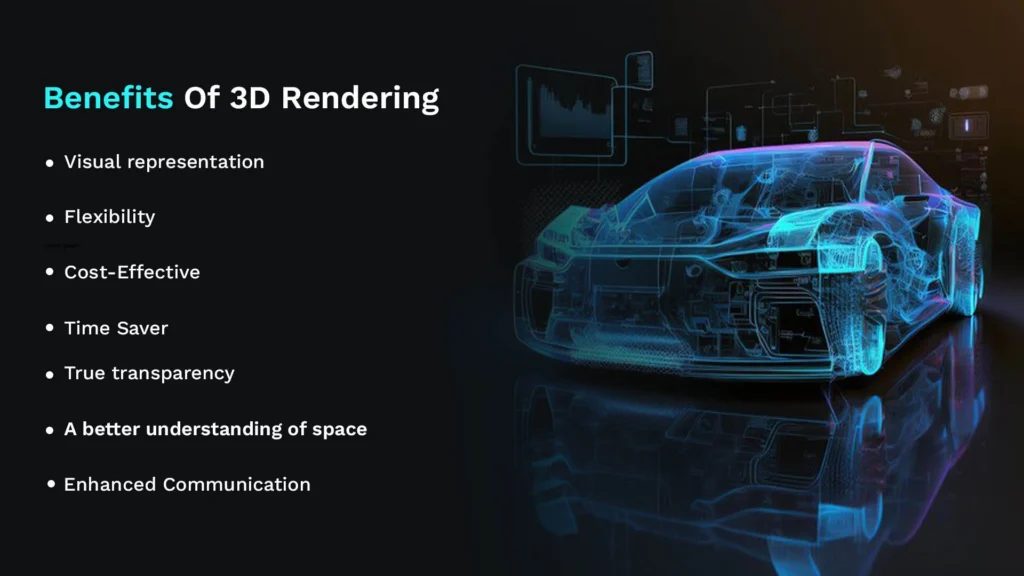
3D rendering has many advantages, including:
- Visual representation: It often provides a more accurate and detailed visual representation of an object or environment than 2D images. This is useful for design, visualization, and communication purposes.
- Flexibility: It makes it easy to design and modify because changes are made quickly and easily without starting from scratch.
- Cost-Effective: It is less expensive than a photo or video production because it requires no bodies, actors, or equipment.
- Time Saver: It can save time in the design and build process as it does not require a physical model or model that can take time to create and modify.
- True transparency: 3D rendering can create transparency of objects and environments useful for business and advertising.
- A better understanding of space can help architects and designers better understand the relationship between objects and the environment, making the design more effective and usable.
- Enhanced Communication: It can improve communication between designers, clients, and stakeholders by providing a clear and detailed design view.
Challenges of 3D Rendering
Despite these advantages, some challenges are associated with 3D rendering, for example:
- Complexity: 3D rendering can be difficult and requires specialized skills and software, making it difficult and costly for some businesses.
- Computing Power: It requires a lot of processing power and resources; this can be difficult for businesses without access to high-end hardware.
- Time-consuming: It can take a long time, which slows down design and production, especially in complex models or environments.
- Realism: Achieving high levels of realism in 3D rendering can be difficult because it requires accurate modeling of lighting, materials, and textures.
- Cost: It can be expensive, especially for large projects, as it often requires a team of professionals to complete.
- Compatibility: 3D rendering software and input files may not be compatible with all hardware and software, causing problems with collaboration and sharing.
- Learning Curve: Using this software can be challenging, especially for those new to computer graphics or design.
However, 3D Rendering has its downside too. With the same editing algorithms, the final images can turn out to be plain and even dull at times. Here is an example.
How AI has Transformed this Industry
Artificial intelligence (AI) greatly impacts the 3D rendering industry, changing the way designers and artists create and create 3D visuals.
Spyne is the leading Artificial intelligence company that provides AI 3d rendering online and offline. Some of the ways Spyne’s AI is changing the 3D rendering industry are:
Augmented Reality: AI can help improve the accuracy of 3D visualization by simulating lighting and shadows that are difficult or time-consuming to do manually.
Faster rendering times: The AI rendering engine accelerates design and manufacturing by producing high-quality images and animations faster than traditional rendering methods.
Generative Design: We use AI to generate new design ideas by analyzing existing patterns and creating new variations based on specifications and constraints.
Personalization: We use AI to customize 3D visualizations based on user preferences and other information, improving interaction and user experience.
Quality Control: We use AI tools to identify and correct errors in 3D models and visualizations and improve overall product quality.
Usability: AI-driven tools and platforms can make rendering more accessible to non-experts as they remove the complex tasks involved in the process.
Cost-effective: Spyne application provides results in a shorter span using their AI technology with very minimum charges. It is also one of the most used 3d rendering software.

